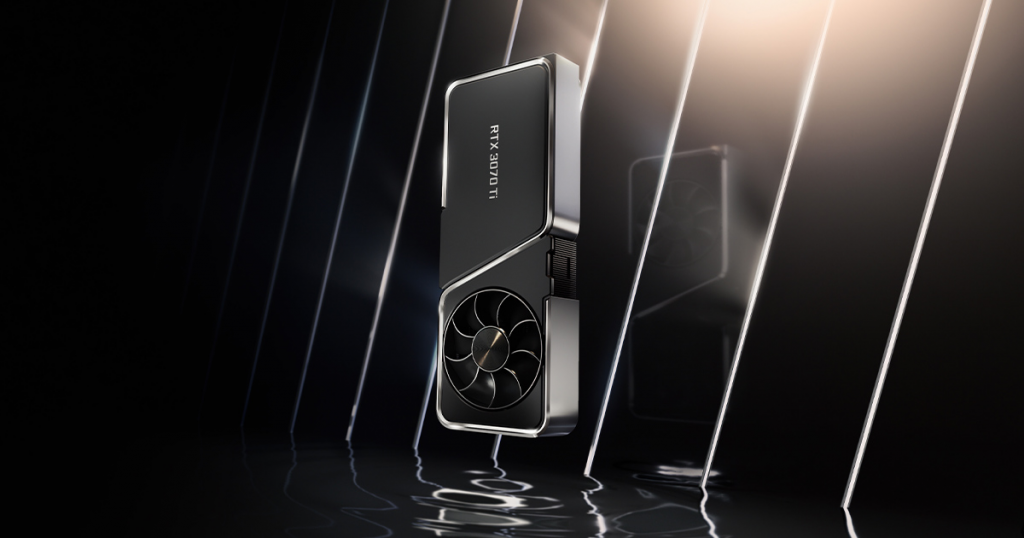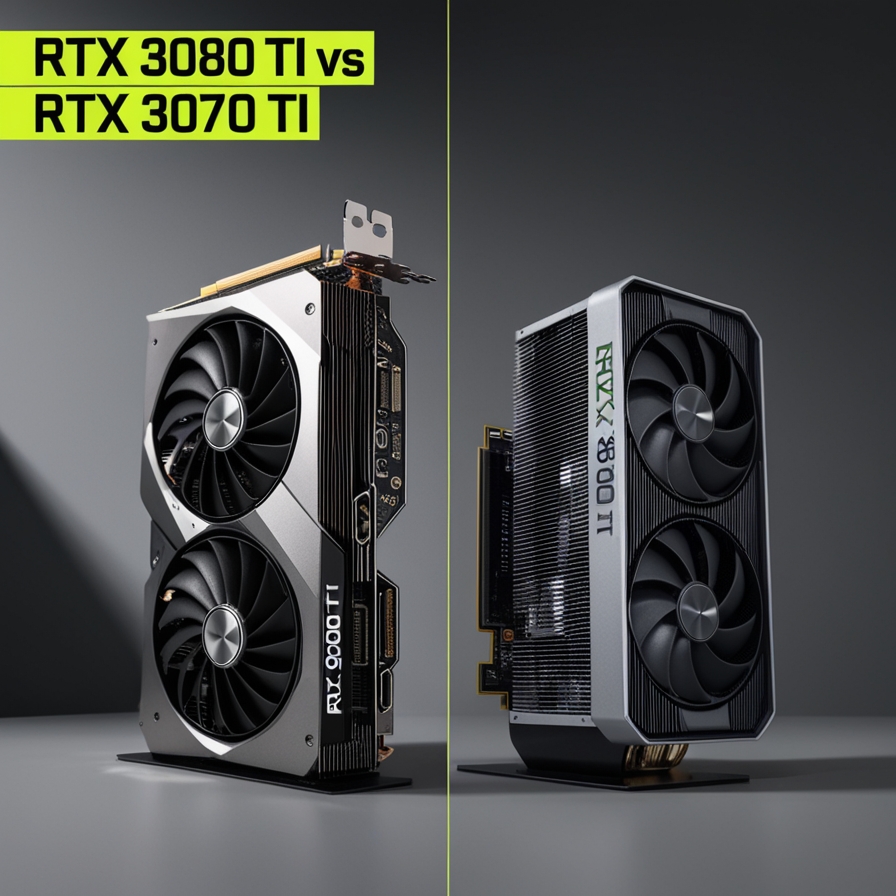Imagine setting up your ultimate gaming or creative workstation, only to realize your graphics card might be holding you back. Choosing the right GPU is crucial, as it affects everything from gaming performance to productivity. NVIDIA’s GeForce RTX 3080 Ti and RTX 3070 Ti are top-tier contenders, but which one is the better fit for your needs? Let’s explore these GPUs from a fresh perspective to help you make an informed choice.
The RTX 3080 Ti: A Glimpse into High-End Performance

Starting with the GeForce RTX 3080 Ti, this GPU is a powerhouse in NVIDIA’s lineup. It boasts an impressive 10,240 CUDA cores and a clock speed of 1.37 GHz, boosting to 1.67 GHz, coupled with 12 GB of GDDR6X memory. This card is built for enthusiasts who demand top-tier performance, whether for high-resolution gaming, detailed content creation, or other intensive applications.
The RTX 3080 Ti shines in 4K gaming, offering smooth frame rates even in the most demanding titles. Its support for advanced technologies like ray tracing and Deep Learning Super Sampling (DLSS) enhances graphical detail and boosts performance. However, this exceptional performance comes at a higher price and increased power consumption.
RTX 3070 Ti: Balancing Power and Affordability

In contrast, the GeForce RTX 3070 Ti provides a more cost-effective option while still delivering high-end performance. Featuring 6,144 CUDA cores and a base clock of 1.58 GHz with an 8 GB GDDR6X memory, this GPU handles gaming well, particularly at 1440p and 1080p resolutions.
While not as powerful as the RTX 3080 Ti, the RTX 3070 Ti still supports ray tracing and DLSS, making it a compelling choice for gamers and creators looking for solid performance without breaking the bank. It strikes a balance between power and affordability.
Comparing Key Specifications
Here’s a detailed comparison to help you assess the key features of these GPUs:
| Feature | RTX 3080 Ti | RTX 3070 Ti |
|---|---|---|
| Architecture | Ampere | Ampere |
| CUDA Cores | 10,240 | 6,144 |
| Base Clock | 1.37 GHz | 1.58 GHz |
| Boost Clock | 1.67 GHz | 1.77 GHz |
| Memory | 12 GB GDDR6X | 8 GB GDDR6X |
| Memory Interface | 384-bit | 256-bit |
| Memory Bandwidth | 912 GB/s | 608 GB/s |
| Ray Tracing Cores | 2nd Generation | 2nd Generation |
| Tensor Cores | 3rd Generation | 3rd Generation |
| DLSS Support | Yes | Yes |
| RT Core Performance | 34 TFLOPs | 21 TFLOPs |
| Tensor Core Performance | 136 TFLOPs | 85 TFLOPs |
| Total Graphics Power (TGP) | 350W | 290W |
| Recommended PSU | 750W | 600W |
| PCI Express | PCIe 4.0 | PCIe 4.0 |
| Outputs | HDMI 2.1, 3x DP 1.4a | HDMI 2.1, 3x DP 1.4a |
| Maximum Resolution | 7680×4320 | 7680×4320 |
| DirectX Version | 12 Ultimate | 12 Ultimate |
| OpenGL Version | 4.6 | 4.6 |
| Multi-Display Support | Up to 4 Displays | Up to 4 Displays |
| NVIDIA Reflex | Yes | Yes |
| NVIDIA Broadcast | Yes | Yes |
| NVIDIA Encoder | 7th Generation | 7th Generation |
| NVIDIA Decoder | 5th Generation | 5th Generation |
| Cooling Solutions | Custom designs | Custom designs |
| Dimensions | Varies by manufacturer | Varies by manufacturer |
| Price Range (at launch) | $1,199 USD | $599 USD |
Architectural Insights
The RTX 3080 Ti’s higher core count and increased memory are tailored for demanding applications. This results in enhanced performance for 4K gaming and intensive tasks like 3D rendering.
In contrast, the RTX 3070 Ti, while slightly less powerful, offers solid performance and benefits from the same Ampere architecture. It’s designed to be efficient and powerful, but on a smaller scale.
Gaming Performance: A Closer Look
The gaming experience varies with each GPU. The RTX 3080 Ti excels in 4K gaming, delivering high frame rates in demanding titles such as Cyberpunk 2077 and Red Dead Redemption 2.
For those gaming at 1440p, the RTX 3070 Ti provides more than adequate performance. It achieves high frame rates and handles 4K gaming with some settings adjustments, thanks to its DLSS support.
Productivity Performance
When it comes to productivity, the RTX 3080 Ti’s higher core count and memory make it more adept at handling complex tasks like video editing and 3D rendering.
The RTX 3070 Ti performs well in these areas as well. While it may be slower in rendering complex scenes, it remains a capable option for those who engage in occasional content creation or data processing.
Future-Proofing Your GPU Investment
Investing in a GPU involves considering future needs. The RTX 3080 Ti’s superior specifications offer better longevity, making it a more future-proof option for evolving gaming and application requirements.
The RTX 3070 Ti, although slightly less powerful, still offers future-proofing for those gaming at 1440p or 1080p. It will perform well for several years but may require an upgrade sooner for 4K gaming or more demanding tasks.
Cost vs. Performance: Evaluating Value
For those looking at cost versus performance, the RTX 3070 Ti offers a more budget-friendly option without sacrificing too much performance. It’s ideal for gamers seeking high performance at a lower price.
The RTX 3080 Ti, with its higher cost, provides superior performance that can be worth the investment for gamers and professionals who need the best. Its price reflects its advanced capabilities and better future-proofing.
Who Should Choose Which GPU?
Choosing the right GPU depends on your needs. If you’re a casual gamer or mainly play at 1440p, the RTX 3070 Ti is likely the better choice, offering great performance at a lower price.
For competitive gamers, content creators, or those requiring top performance, the RTX 3080 Ti is the superior option. It’s ideal for 4K gaming and heavy workloads, ensuring the best possible experience.
Power Consumption and Efficiency
The RTX 3080 Ti requires a 750W PSU and generates more heat, necessitating a robust cooling solution.
The RTX 3070 Ti, being more power-efficient with a 600W PSU requirement, operates cooler, making it suitable for smaller builds or energy-conscious users.
Aesthetics and Build Quality
Both GPUs are well-designed with high-quality materials. The RTX 3080 Ti’s larger size might be challenging for small cases, while the RTX 3070 Ti’s more compact form offers greater flexibility.
Both cards are built to last and feature customization options such as RGB lighting for a visually appealing setup.
Community and Ecosystem Support
NVIDIA’s strong community and ecosystem support enhance both GPUs. The GeForce Experience software simplifies driver updates and game optimization, with positive user feedback highlighting both cards’ performance and reliability.
A wide range of compatible components and accessories supports both GPUs, making upgrades or new builds easier.
Final Verdict
In summary, the RTX 3080 Ti and RTX 3070 Ti each serve distinct needs. The RTX 3080 Ti is ideal for those seeking top performance, especially for 4K gaming and professional tasks. However, its higher cost might not be necessary for everyone.
The RTX 3070 Ti provides excellent value, offering strong performance at a more accessible price. It’s a great option for most gamers and creators who want high-end capabilities without the premium cost.
Your choice should align with your specific needs, budget, and future plans. Both GPUs offer impressive performance and features, ensuring a solid gaming or creative experience.

Leave a Reply
You must be logged in to post a comment.